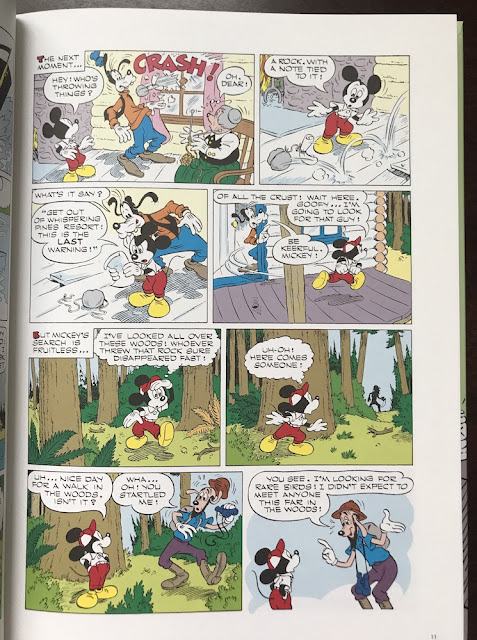The Case of the Vanishing Bandit, by Paul Murry
2018, reprinting comics from the 1950s
Fantagraphics make the most beautiful books! I had no intention of buying this, but the two-book slipcase set was marked down 90% to ¥773, how could I not buy it?
 |
| Absolutely gorgeous production, right down to the paper quality |
(I knew a lady who couldn't handle seeing stray kittens in the street, she had to give them some food and in some cases shelter. That's how I feel when I see comic collections marked down over 80%. They need love, they need a home, and I'm there for it.)
For a lot of this book (only one of the two in the slipcase), I kind of hated it. Going in, you have to accept it's a product of it's time, it's really aimed at kids, and not in a wink-wink EC way. The art quality is fine, but this thing read like a story that they threw together to get out on a deadline. The obvious point of comparison for this book and the whole Disney Masters series is Carl Barks. Fantagraphics is already around 20 books into its Barks' Duck reprints, and they decided he would get a line of books to himself. Murry and some other Disney comics artists are getting a single line to share. Though it probably reflects the realities of publishing, that Murry doesn't have the name draw to justify his own line, Fantagraphics has been willing to create a name for artists they deem worthy. This work seems more in the vein of historically interesting than it is historically important.
 |
| Some nature shots |
The big problem I had with it was it felt uninspired. In the Barks books, the world is populated with all manner of character in Duckville. Bringing in Gladstone Gander or Gyro Gearloose gives a little punch to stories, different flavors for each adventure. Here, you get a side character like Chief O'Hara, who is Irish. That's all I could tell you about this character. These are Murry's early stories, and the book notes state that he later created The Phantom Blot, who became Mickey Mouse's comic nemesis, so I might simply have read stories which don't reflect the breadth of Murry's career.
 |
That final panel: not even a pun or a callback. Just a statement summarizing the plot. It's shaped like a joke, but it isn't one |
A much greater flaw is just the construction of the stories themselves. A crime is established in part one, investigated in part two, and solved in part three. There's no real cleverness in the unveiling of the plot, it is textbook writing. No "Chekov's gun", just Mickey solving a mystery in 24 pages. It's not bad, but it's fairly boring.
 |
| Some pages are dynamic and have really solid cartooning that would work today, with some updates to the settings |
The lettering looks close to that of Barks' books, and it looks amazing. That was probably my favorite part of the book. I can only dream of that sort of hand-eye coordination.
 |
| A guy was trying to blow Mickey and Goofy up with dynamite, but they decide not to press charges. If this was an EC book, he would have gone to the gas chamber |
I'm glad I read it, and by the end I could find some things to enjoy in the book. If I were to read more of his work, I'd probably want to skip to the 70s to see what he was doing then. But it's not something I'm dying to track down unless it's a good deal.

No comments:
Post a Comment